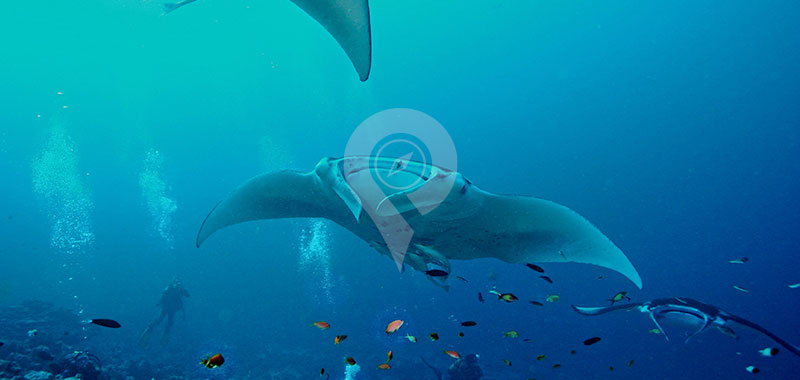The Galapagos waters, renowned for their rich biodiversity, serve as a haven for an intriguing variety of marine species, particularly the majestic Mobula Rays. Within this marine sanctuary, two distinctive species of Mobula Rays are predominantly observed: the Mobula Birostris, commonly referred to as the Giant Oceanic Manta Ray, and the Mobula Japanica, known as the Spinetail Devil Ray. The Giant Oceanic Manta Ray is celebrated for its impressive size and gentle nature, making it a favorite among marine enthusiasts. In contrast, the Spinetail Devil Ray is easily identifiable by its unique physical feature—protruding 'horns' on each side of its expansive head, giving it a devil-like appearance. These 'horns' are actually cephalic fins, rolled up in a distinctive manner. The Galapagos archipelago's nutrient-rich waters provide an ideal habitat for these rays, supporting a diverse ecosystem where they thrive. This makes the region a must-visit destination for anyone interested in marine biology or eager to witness these extraordinary creatures in their natural environment.
Essential Insights: Mobula Rays at a Glance
Category of Fauna: Aquatic Wildlife
Scientific Classification: Species under Myliobatiformes
Typical Size Range: From 1 meter to an impressive 8 meters in length
Weight Spectrum: Can weigh as much as 1300 kilograms
In these concise yet informative points, we capture the essence of the Mobula Rays' characteristics. Their classification within the Myliobatiformes group highlights their unique place in the marine ecosystem. The considerable variation in size, ranging from a modest one meter to a stunning eight meters, showcases their diverse growth potential. Furthermore, their substantial weight, reaching up to 1300 kilograms, underscores their majestic presence in the oceans. These facts collectively provide a quick yet comprehensive understanding of these magnificent sea creatures.
Engaging with Humans
These rays exhibit a remarkable curiosity towards humans. They frequently accompany scuba divers and snorkelers on aquatic adventures in the Galapagos, showing a surprising level of interaction and even enjoyment in human company. Notably, the Galapagos Manta Rays are known for their spectacular aerial displays, leaping out of the water and creating a thunderous splash upon re-entry. Their cognitive abilities are noteworthy too, as they possess the largest brains among fish species.
Vulnerability and Conservation
Despite their few natural predators, Mobula Rays face vulnerability, primarily due to accidental capture in fishing nets and their slow reproductive cycles. This has led to a gradual decline in their population, highlighting the need for concerted conservation efforts.
Seasonal Convergence
The Galapagos and Ecuadorian coastline host the world's largest seasonal congregations of Giant Manta Rays. Witnessing these majestic creatures in their natural habitat is an awe-inspiring experience, adding a magical touch to any island cruise.
Diverse and Distinct Species
The Galapagos archipelago is home to various ray species, each unique in appearance and behavior. The Spotted Eagle Rays boast a striking pattern of luminescent white dots on a black backdrop, while the Golden Rays' sandy topsides provide perfect camouflage against the ocean floor. The Manta Rays, with their impressive wingspan reaching up to eight meters, are a sight to behold.
Anatomy and Movement
Belonging to the cartilaginous fish family, closely related to sharks, rays have a flat, circular body and a long tail. Their Spanish name 'manta', meaning carpet, aptly describes their flat, carpet-like bodies. They swim with a graceful, undulating motion, moving their fins like wings in flight, in stark contrast to the side-to-side movement of sharks.
Reproduction
Rays have a unique reproductive process known as ovoviviparity. They lay eggs, which are then carried within their bodies for about a year. Upon hatching, the rays expel the young, a fascinating aspect of their life cycle.
Prime Locations in Galapagos
Mobula Rays can be spotted in various locations around the Galapagos Islands, including Isabela, Santiago, Marchena, Mosquera, and Floreana. Each site offers a unique opportunity to witness these magnificent creatures in their natural environment.



